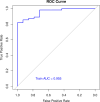The polygenic implication of clopidogrel responsiveness: Insights from platelet reactivity analysis and next-generation sequencing
- PMID: 38991024
- PMCID: PMC11239111
- DOI: 10.1371/journal.pone.0306445
The polygenic implication of clopidogrel responsiveness: Insights from platelet reactivity analysis and next-generation sequencing
Abstract
Clopidogrel is widely used worldwide as an antiplatelet therapy in patients with acute coronary disease. Genetic factors influence interindividual variability in response. Some studies have explored the polygenic contributions in the drug response, generating pharmacogenomic risk scores (PgxPRS). Importantly, these factors are less explored in underrepresented populations, such as Latin-American countries. Identifying patients at risk of high-on-treatment platelet reactivity (HTPR) is highly valuable in translational medicine. In this study we used a custom next-generation sequencing (NGS) panel composed of 91 single nucleotide polymorphisms (SNPs) and 28 genes related to clopidogrel metabolism, to analyze 70 patients with platelet reactivity values, assessed through closure time (CT). Our results demonstrated the association of SNPs with HTPR and non-HTPR, revealing the strongest associations with rs2286823 (OR: 5,0; 95% CI: 1,02-24,48; p: 0,03), rs2032582 (OR: 4,41; 95% CI: 1,20-16,12; p: 0,019), and rs1045642 (OR: 3,38; 95% CI: 0,96-11,9; p: 0,05). Bivariate regression analysis demonstrated the significant association of several SNPs with the CT value, a "surrogate" biomarker of clopidogrel response. Exploratory results from the LASSO regression model showed a high discriminatory capacity between HTPR and non-HTPR patients (AUC: 0,955), and the generated PgxPRS demonstrated a significant negative association between the risk score, CT value, and the condition of HTPR and non-HTPR. To our knowledge, our study addresses for the first time the analysis of the polygenic contribution in platelet reactivity using NGS and establishes PgxPRS derived from the LASSO model. Our results demonstrate the polygenic implication of clopidogrel response and offer insights applicable to the translational medicine of antiplatelet therapy in an understudied population.
Copyright: © 2024 Echeverría et al. This is an open access article distributed under the terms of the Creative Commons Attribution License, which permits unrestricted use, distribution, and reproduction in any medium, provided the original author and source are credited.
Conflict of interest statement
The authors have declared that no competing interests exist.
Figures






Similar articles
-
CRISPLD1 rs12115090 polymorphisms alters antiplatelet potency of clopidogrel in coronary artery disease patients in Chinese Han.Gene. 2018 Dec 15;678:226-232. doi: 10.1016/j.gene.2018.08.027. Epub 2018 Aug 7. Gene. 2018. PMID: 30096456
-
Pharmacometabolomics analysis of plasma to phenotype clopidogrel high on treatment platelets reactivity in coronary artery disease patients.Eur J Pharm Sci. 2018 May 30;117:351-361. doi: 10.1016/j.ejps.2018.03.011. Epub 2018 Mar 8. Eur J Pharm Sci. 2018. PMID: 29526765
-
High on-treatment platelet reactivity on commonly prescribed antiplatelet agents following transient ischaemic attack or ischaemic stroke: results from the Trinity Antiplatelet Responsiveness (TRAP) study.Eur J Neurol. 2013 Feb;20(2):344-52. doi: 10.1111/j.1468-1331.2012.03861.x. Epub 2012 Sep 20. Eur J Neurol. 2013. PMID: 22994699 Clinical Trial.
-
How to improve the concept of individualised antiplatelet therapy with P2Y12 receptor inhibitors--is an algorithm the answer?Thromb Haemost. 2015 Jan;113(1):37-52. doi: 10.1160/TH14-03-0238. Epub 2014 Sep 18. Thromb Haemost. 2015. PMID: 25231675 Review.
-
Clinical impact of genetically determined platelet reactivity.J Cardiovasc Transl Res. 2013 Jun;6(3):398-403. doi: 10.1007/s12265-012-9421-4. Epub 2012 Nov 13. J Cardiovasc Transl Res. 2013. PMID: 23149816 Review.
References
-
- Zwart B, Godschalk TC, Zheng K, Denteneer J, Kelder JC, Ten Berg JM. Measuring high on-treatment platelet reactivity in clinical practice; should we use a panel of platelet function tests? Blood Coagulation & Fibrinolysis. 2019. Sep;30(6):263–9. - PubMed
MeSH terms
Substances
LinkOut - more resources
Full Text Sources
Medical

